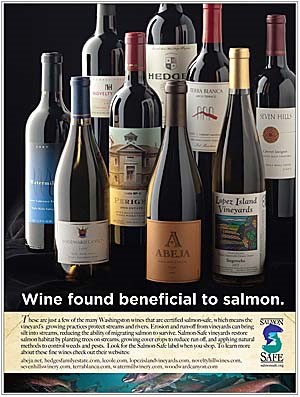 A program that began by certifying vineyards in Oregon’s Willamette Valley that were following practices to protect and restore salmon watersheds has grown to include more than half the wine grape acreage of Walla Walla Valley in Washington and Oregon and several vineyards in eastern Washington.
A program that began by certifying vineyards in Oregon’s Willamette Valley that were following practices to protect and restore salmon watersheds has grown to include more than half the wine grape acreage of Walla Walla Valley in Washington and Oregon and several vineyards in eastern Washington.
Using catchy ad campaigns, like “Sip. Save.” for wine and “How to drink like a fish” for micro-brewed beer, the Pacific Northwest certification program Salmon Safe, Inc., has found success with its market-based approach to encourage watershed protection. The fish logo, one of the first regional ecolabels in the nation, is now found on a host of agricultural crops, from blueberries, vegetables, and hazelnuts to flowers, hops, milk and eggs, wine, and more.
But Salmon Safe, originally founded by the Pacific Rivers Council before becoming an independent nonprofit organization, has not limited its focus to just agriculture. Recognizing that urban centers in the Pacific Northwest can have a major effect on watersheds, Salmon Safe has certified an urban residential development, a city convention center, city parks, a college, and Nike’s corporate campus in Portland, Oregon.
During a session on sustainability at the annual meeting of the Washington Association of Wine Grape Growers, Dan Kent, co-founder and managing director of Salmon Safe, shared how sustainability can be successfully promoted in the marketplace. Kent, who has been involved in promoting Salmon Safe wines for more than a decade, believes that wine is in a leadership position when it comes to marketing sustainability.
“In the last 15 years, there’s been a huge shift in the way wine grapes are grown, towards more sustainable practices,” he said, adding that the epicenters have been in California’s Lodi-Woodbridge region, the Walla Walla ¬Valley, and Washington’s Red Mountain appellation. “We’re seeing that ecological and sustainable wine grape growing is now mainstream.”
Seven sins
But the expansion in the marketplace of organic and sustainable products has also led to proliferation of ecolabels and all kinds of claims about products that can’t always be substantiated, Kent said. Since 2006, there have been three times as many environmental claims in the marketplace, he added.
In a recent market research survey, TerraChoice Environmental Marketing, Inc., looked at the use of misleading environmental claims, a practice called greenwashing. Kent said that TerraChoice studied more than 1,000 consumer products bearing more than 1,750 environmental claims in six major big-box stores. All but one of the products examined made claims that were demonstrably false or could mislead intended audiences.
Kent said that most of the products reviewed in the survey committed what TerraChoice calls the “Seven Sins of Greenwashing.” The seven sins include:
—Sin of the hidden trade-off
—Sin of no proof
—Sin of vagueness
—Sin of irrelevance
—Sin of fibbing
—Sin of lesser of two evils
—Sin of worshipping false labels
“These sins really make the case for third-party certification,” he said, adding that third-party certification helps ensure that the claim is credible.
By partnering with the Oregon-based Low Input Viticulture and Enology certification program, Salmon Safe has made it easy for growers to simultaneously be Salmon Safe certified when they go through the steps for LIVE certification. The partnership has been useful to Walla Walla Valley wine grape growers who are members of Vinea, a Walla Walla Valley sustainable wine grape program, because they too are linked with LIVE and Salmon Safe.
However, growers can individually follow Salmon Safe practices without being involved in other certification programs. Farming practices that Salmon Safe is interested in include riparian and wetland management, irrigation use, erosion and sediment control, biological diversity, and fertility and integrated pest management programs.
“We require whole-farm certification,” Kent said, which means that all crops and areas of a farm must be involved in watershed protection, not just wine grapes or one area. He noted that being organic does not mean automatic qualification for Salmon Safe, as their scope is broader than organic requirements.
Market success
To promote Salmon Safe wines, a two-pronged approach is taken. Salmon Safe logos and materials are used in wine tasting rooms, sharing the message one on one with consumers, and in retail markets, supported by targeted advertising efforts.
Salmon Safe consumer promotions have been implemented in hundreds of U.S. retail markets and in targeted cities. When Salmon Safe promotions (billboards, bus signs, point-of-purchase displays) have been held in ¬targeted markets, they have seen a consumer response of wine sales increasing by 20 percent, Kent said. “But we don’t see the sales sustained over time when the ¬campaign ends.”
Other methods of reaching consumers include wallet cards that list Salmon Safe certified vineyards, wineries, and wines, and under development is an iPhone application that consumers could use to guide their wine ¬purchases.
Kent believes that the increase in sales when Salmon Safe wines are promoted shows that consumers are hungry for information about wine. “We’ve found that the environmental message—if you can break through all that background noise—is compelling to consumers.”

Leave A Comment